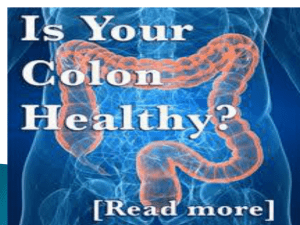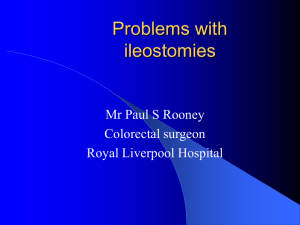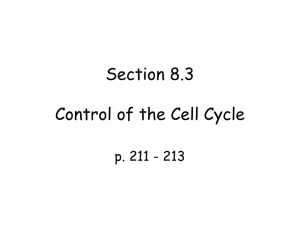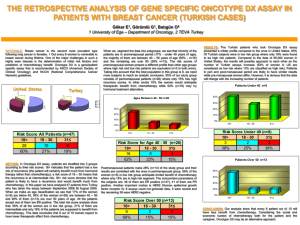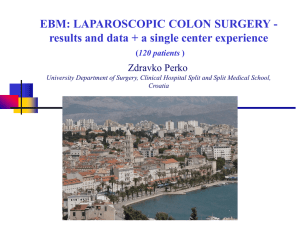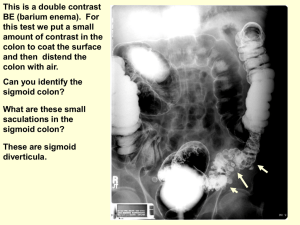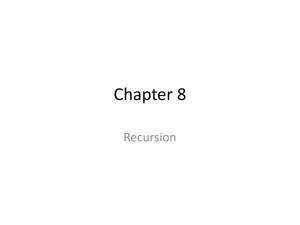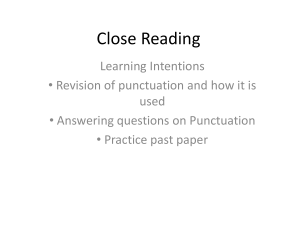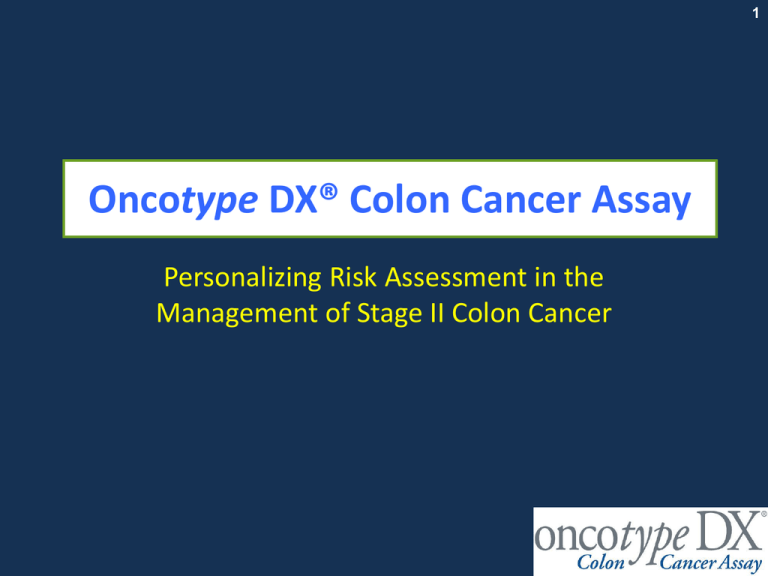
1
Oncotype DX® Colon Cancer Assay
Personalizing Risk Assessment in the
Management of Stage II Colon Cancer
2
Agenda
• The Need for Individualized Treatment
Decisions in Stage II Colon Cancer
• Development of the Genomic Health
Oncotype DX® Colon Cancer Assay
• QUASAR Validation Study Results
3
Case Study Presentation
• 65 yr old woman, no significant PMHx, presented with 6 month
history of constipation, found to have modest iron-deficiency
anemia (Hct 35), colonoscopy positive for descending colon
tumor mass, now recovering well s/p left hemicolectomy.
– 2.2 cm tumor mass descending colon resected, negative
surgical margins
– 0 of 13 nodes positive
– Stage II (T3, N0, M0) colon cancer
– Moderately differentiated adenocarcinoma (Low Grade)
– No lymphatic or vascular invasion
How should this patient be evaluated for treatment?
What is her risk of disease recurrence?
How likely is she to benefit from chemotherapy?
4
The challenge: Which stage II colon cancer
patients should receive adjuvant chemotherapy?
• Unclear which 75-80% of patients cured with surgery alone
• Absolute chemotherapy benefit small
• Chemo has significant toxicity and impacts quality of life
• Median age 71 years old, co-morbidities and competing
causes of mortality
• Selection of patients for chemotherapy is subjectively based on:
– Risk assessment with a limited set of clinical/pathologic
markers
– Patient age, co-morbidities, patient preference
5
Current Management of
Stage II Colon Cancer
• NCCN Guidelines list wide range of “acceptable” management
strategies for resected stage II colon cancer:
– Observation
– 5FU/LV or capecitabine
– 5FU/LV/oxaliplatin (for high risk features)
– Clinical trial
• Estimated % receiving adjuvant therapy:
25-35%
– Use of adjuvant regimens in practice today*:
• 5FU/LV
19%
• Capecitabine
10%
• FOLFOX
60%
• Other
11%
NCCN® Clinical Practice Guidelines for Oncology: Colon Cancer v2.2011
*OncoReport: Medical Oncology T1 2009, Interactive Clinical Intelligence, www.icimrr.com
6
Existing Tools for Selecting Stage II Patients for
Treatment Are Inadequate
Recurrence Risk
Treatment Benefit
•
•
•
•
•
•
•
• MMR?
Bowel obstruction or perforation
T-Stage
# of nodes assessed
Tumor grade
Lymphatic/vascular invasion
Margin status
MMR
According to current guidelines*:
• Unlike in breast cancer, there are no molecular markers that have been routinely
established in clinical practice for stage II colon cancer.
• Use of MMR to assess recurrence risk and treatment benefit is an evolving area
in guidelines and currently recommended if using single-agent fluoropyrimidine
• Treatment decisions today are based on the expectation that higher risk stage II
patients derive larger absolute benefit with adjuvant chemotherapy.
* NCCN® Clinical Practice Guidelines for Oncology: Colon Cancer v2.2011
ASCO® Recommendations on Adjuvant Chemotherapy for Stage II Colon Cancer, JCO, 2004.
ASCO is a registered trademark of the American Society of Clinical Oncology. ASCO does not endorse any product or therapy.
7
Existing Tools for Selecting Stage II Patients for
Treatment Are Inadequate
• Guidelines: presence of any existing risk marker categorizes
patients into “higher risk” vs “standard risk” groups
– No further discrimination for “standard risk” (the majority)
– Not individualized or quantitative
• In the absence of established predictive markers, treatment
decisions today are based on the expectation that higher risk
stage II colon cancer patients derive larger absolute benefit
with adjuvant chemotherapy
NCCN Clinical Practice Guidelines for Oncology: Colon Cancer v2.2011
ASCO® Recommendations on Adjuvant Chemotherapy for Stage II Colon Cancer, JCO, 2004.
8
Stage II Colon Cancer:
T4 Stage Predicts High Recurrence Risk
SEER database 1991-2000: 119,363 colon cancer patients
5-yr risk of death:
17.5% all Stage II
15.3% Stage IIa (T3N0)
27.8% Stage IIb (T4N0)
17% of Stage II patients had T4 tumors
• Significantly worse outcome for T4
• T3 is not a “low risk” factor – very near average risk
O’Connell 2004 JNCI 96:1420
9
Mismatch Repair Deficiency (MMR-D):
Unique Biological Subgroup of Colon Cancer
IHC for MMR
protein status
MLH1+
MSH2-
MLH1-
MSH2+
Thus, IHC for MMR proteins
PCR onand
tumorPCR for MSI detect two
for tumor
MSI
manifestations of the DNA
same
biology:
(microsatellite
•MMR-D is synonymous
with MSI-H
instability)
Imai and Yamamoto. Carcinogenesis 2008
•MMR-P
synonymous
with MSI-L/MSS
Umetani, Annals
of Surgical is
Oncology
2000
Rosen et al. Modern Pathology (2006) 19, 1414-1420
10
MMR-D Identifies Resected Colon Cancer
Patients With Low Recurrence Risk
No adjuvant chemotherapy n=287
MMR-D
MMR-P
•
•
Multiple studies have consistently demonstrated that the ~15% patients
with MMR-D have markedly lower recurrence risk than the average
stage II colon cancer patient
MMR not yet a standardized marker in clinical practice
Ribic 2003 NEJM 349:247
11
MMR-D and Disease Free Survival in Stage II Colon
Cancer: Utility of Adjuvant 5FU Therapy
Whether 5FU is harmful in MMR-D patients remains controversial, but at best,
5FU appears to yield little, if any, benefit for MMR-D patients
Sargent 2010 JCO 28:3219
12
ECOG 5202
Molecular Stratification in Stage II Colon Cancer
Randomize:
FOLFOX vs
FOLFOX + bevacizumab
High Risk:
MSS/MSI-L
with 18q LOH
Stage II
colon
cancer
Tumor
MSI &
18qLOH
Low Risk:
MSI-H, or
MSS/MSI-L
without 18q LOH
Observation
• Opened 8/2005, Target enrollment: 3610, still accruing
• Considerations:
• Mixed literature for prognostic importance of 18q LOH
• MSI-H patients not randomized
• Negative NSABP C-08 , AVANT results
Adapted from Vicuna & Benson 2007 JNCCN
13
Oncotype DX® Colon Cancer Assay
Development Overview
Technical Feasibility
Gene Discovery & Refinement
Analytical Validation
Clinical Validation
14
Key Themes
• Importance of understanding and treating the
underlying individual tumor biology
• Genomic assays for clinical decision-making must be
“Fit for purpose”
– Clinically validated in prospectively-designed studies of
sufficient size and statistical power
– Supported by evidence in target patient population,
with demonstrated value beyond existing measures
– Standardized and reproducible
– Practical and clinically impactful
DX®
Oncotype
Breast Cancer Assay:
A Widely Adopted, Quantitative RT-PCR Assay
15
Clinical Experience in >175K cases
Recurrence Score® in N-, ER+ patients
Low Recurrence Score Disease
• Lower likelihood of recurrence
• Greater magnitude of TAM benefit
• Minimal, if any, chemotherapy benefit
High Recurrence Score Disease
• Greater likelihood of recurrence
• Lower magnitude of TAM benefit
• Clear chemotherapy benefit
1) Paik et al NEJM 2004, 2) Habel et al Breast Cancer Research 2006
3) Paik et al JCO 2006, 4) Gianni et al JCO 2005
16
Development Strategy for the Oncotype DX®
Breast Cancer Assay
2001
Breast Cancer Technical Feasibility
2002
Model Building Studies Based on 250 genes
2002
Selection of Final 21-Gene List & Algorithm
2003
Standardization and Validation of Analytical Methods
2003
Validation Studies in NSABP B-14 and Kaiser Permanente
17
Development and Validation of a
Multi-Gene RT-PCR Colon Cancer Assay
Colon Cancer Technical Feasibility
Development Studies
Surgery Alone
NSABP C-01/C-02 (n=270)
Development Studies
Surgery + 5FU/LV
NSABP C-04 (n=308)
Cleveland Clinic (n = 765)
NSABP C-06 (n=508)
Selection of Final Gene List & Algorithm
Standardization and Validation of Analytical Methods
Clinical Validation Study – Stage II Colon Cancer
QUASAR (n=1,436)
Test Prognosis and Treatment Benefit
Kerr et al., ASCO® 2009, #4000
18
Oncotype DX® Colon Cancer Assay
Development Overview
Technical Feasibility
Gene Discovery & Refinement
Analytical Validation
Clinical Validation
19
RT-PCR for RNA Quantification from Fixed
Paraffin-Embedded Tumor Tissue
Reporter
Forward
Primer
R
Probe
Quencher
Q
Polymerization
Reverse
Primer
R
Q
Strand Displacement
and Cleavage of Probe
Q
R
Polymerization
Completed
Clark-Langone, BMC Genomics: 2007; 8:279.
Cronin et al. Am J Pathol. 2004;164:35-42
Oncotype DX® Colon Cancer
Technical Feasibility Studies
• RNA yield and RNA quality after extraction from FPET tissues
• Gene expression differences and similarities between whole
section and enriched colon tumor tissue sections
– Established need for manual microdissection of colon
tumor specimens
• Reference gene selection
– Compensates for known variability of pre-analytical factors
(e.g. Delay to fixation, duration of fixation, fixative)
20
21
Oncotype DX® Process
• Standardized RT-PCR
– Optimized for the small RNA
fragments extracted from
fixed paraffin embedded
tissue (FPET)
– Optimized to be robust with
regard to sources of preanalytic variability such as
•
•
•
•
Delay to fixation
Duration of fixation
Fixative type
Sample age
Cronin et al. Am J Pathol. 2004;164:35-42
22
• Delays to fixation,
duration of fixation,
different fixatives and
sample age can affect
RNA quality
Hollandes
Reference Normalized Expression (CT)
Normalization Accounts for
Known Sources of Preanalytic Variability
• Reference normalization
compensates for these
differences in sample
processing and sample
age
Reference Normalized Expression (CT)
Formalin
Genomic Health, data on file
23
Oncotype DX® Colon Cancer Assay
Development Overview
Technical Feasibility
Gene Discovery & Refinement
Analytical Validation
Clinical Validation
24
Gene Discovery and Gene Refinement Studies:
Oncotype DX® Colon
Correlation between gene expression and recurrence-free interval (RFI)
across four independent studies. Total of 1851 patients.
Treatment
Study and Site
# Patients
(Stage II/III)
# Genes
Surgery Alone
C01/C02
NSABP, Pittsburgh, PA
270
(131/139)
761
Surgery Alone
Cleveland Clinic
Cleveland, OH
765
(504/261)
375
Surgery plus 5FU/LV
C04
NSABP, Pittsburgh, PA
308
(137/171)
761
Surgery plus 5FU/LV
C06
NSABP, Pittsburgh, PA
508
(235/273)
375
O’Connell et al. 2010 JCO 28:3937
25
Identification of Recurrence Genes in
Development Studies
NSABP C01/C02 (surgery alone)
143 genes significant
NSABP C04 (surgery+FU/FA)
143 genes significant
CC (surgery alone)
119 genes significant
NSABP C06 (surgery+FU/FA)
169 genes significant
• 48 (13%) of 375 genes studied in all development studies were significantly
associated with RFI (p<0.05) in both surgery alone and at least one surgery +
FU/FA study
• <1 gene expected to be a false discovery
Kerr D, et al. ESMO 2010 #83PD.
Assessment of 761 Candidate Genes in 1,851 Patients
in the Development Studies to Yield Final
Pre-specified Assay for Validation in QUASAR
26
48 Recurrence and 66 Treatment Benefit Genes Significant
Across Development Studies
Modeling and Analytical Performance
FINAL ASSAY
7 Recurrence Genes
6 Treatment Benefit Genes
RECURRENCE
SCORE
TREATMENT
SCORE
(0-100)
(0-100)
5 Reference Genes
O’Connell et al. 2010 JCO 28:3937
Kerr et al., ASCO® 2009, #4000
27
The 12-Gene Oncotype DX® Colon Cancer
Recurrence Score®
Recurrence Score
STROMAL
FAP
INHBA
BGN
CELL CYCLE
Ki-67
C-MYC
MYBL2
Reference Genes
ATP5E
GPX1
PGK1
UBB
VDAC2
GADD45B
RS = 0.15 x Stromal Group
- 0.30 x Cell Cycle Group
+ 0.15 x GADD45B
O’Connell et al. 2010 JCO 28:3937
Kerr et al., ASCO 2009, #4000
28
Oncotype DX® Colon Cancer Assay
Development Overview
Technical Feasibility
Gene Discovery & Refinement
Analytical Validation
Clinical Validation
Oncotype DX® is Analytically Validated
Assessment of assay performance characteristics and optimal
conditions for accuracy, precision and reproducibility
Assay Finalization in Preparation for Validation
•
•
•
•
•
•
Heterogeneity assessment
PCR amplification efficiency
Finalization of algorithm and cut points
Standard Operating Procedures
Final Assay Format
Calibration and qualification of instruments and reagents
Analytic Validation
• Analytical sensitivity (limits of detection and quantitation)
• Assay precision and linear dynamic range
• Analytical reproducibility
29
30
Oncotype DX® Assay Process Steps:
Defined and Finalized Prior to Validation
1) PRE-ANALYTIC
– Pathology review of the FPET sample by a Board Certified
Anatomic Pathologist
– Mark guide slide for manual microdissection
2) ANALYTIC
– RNA extraction and quantitation (Ribogreen® method)
– qPCR test for residual genomic DNA
– Reverse transcription
– TaqMan PCR
– Data quality control
3) POST-ANALYTIC
– Calculation of Recurrence Score® result
– Report preparation and approval
Analytical Validation of the
Oncotype DX® Colon Cancer Assay
Clark-Langone et al, BMC Cancer 2010
“The high precision of the individual genes translates into a
similarly high level of precision for the stromal gene group
score (SD≤0.04), the cell cycle gene group scores (SD≤0.05)
and the RS (SD≤1.38).”
32
Oncotype DX® Colon Cancer Assay
Development Overview
Technical Feasibility
Gene Discovery & Refinement
Analytical Validation
Clinical Validation
33
A quantitative multi-gene RT-PCR assay for
prediction of recurrence in stage II colon cancer:
Selection of the genes in 4 large studies and results
of the independent, prospectively-designed
QUASAR validation study
David Kerr1, Richard Gray2, Philip Quirke3, Drew
Watson4, Greg Yothers5, Ian Lavery6, Mark Lee4,
Michael O'Connell5, Steven Shak4, Norman
Wolmark5 and the Genomic Health & QUASAR
Colon Teams
1. University of Oxford, Oxford, UK & SIDRA, Qatar; 2. Birmingham Clinical Trials Unit,
Birmingham, UK; 3. Leeds Institute of Molecular Medicine, Leeds, UK; 4. Genomic Health,
Inc., Redwood City, CA; 5. National Surgical Adjuvant Breast and Bowel Project,
Pittsburgh, PA; 6. Cleveland Clinic, Cleveland, OH
34
Stage II Colon Cancer: Overall Goal
• To develop and validate a multi-gene expression
assay which improves treatment decisions for
patients with stage II colon cancer, providing:
– Individualized assessment of recurrence risk
following surgery
– Identification of patients with differential
5FU/LV benefit
– Independent clinical value in the context of other
measures such as T-stage and MMR
– Optimized for fixed, paraffin-embedded colon
tumor tissue
Kerr et al., ASCO® 2009, #4000
35
Clinical Validation of the Pre-specified Colon Cancer
Assay: Stage II Colon Cancer Patients from QUASAR*
Observation
Parent
QUASAR
Trial
Resected
Stage II
Colon Cancer
Adjuvant
treatment
with 5FU/LV
● Enrolled 1994-2003, primarily from UK
● Parent study demonstrated 3-4% absolute benefit of adjuvant
5FU/LV for stage II disease (approximate 20% relative risk
reduction)
* Lancet 2007 370:2020-9
36
QUASAR:
Evaluable Stage II Colon Cancer Patients
Parent QUASAR study
n=3,239
Patients with collected blocks
n=2,197 (68%)
707 cases stage III and
rectal cancer
Confirmed stage II colon cancer
n=1,490 (69%)
Final evaluable population
n=1,436
54 excluded (3.6%):
29 synchronous tumors
8 insufficient tissue
7 identifier queries
6 RNA quality/quantity
4 ineligible histology
Kerr et al., ASCO® 2009, #4000
37
QUASAR:
Demographics of 1,436 Evaluable Patients
Characteristic
Age
Gender
T Stage
# Nodes
Examined
LVI
Tumor Grade
Tumor Type
MMR
Location
Values
<60
60 to <70
70+
Female
T4
<12
≥12
Present
High
Mucinous
Deficient
Right
Surgery Alone
(total = 711)
N (%)
251 (35.3)
308 (43.3)
152 (21.4)
302 (42.5)
108 (15.3)
413 (62.9)
244 (37.1)
90 (12.7)
222 (31.2)
144 (20.3)
89 (13.6)
273 (46.9)
Surgery + 5FU/LV
(total = 725)
N (%)
269 (37.1)
317 (43.7)
139 (19.2)
295 (40.7)
113 (15.7)
409 (61.0)
262 (39.0)
110 (15.2)
219 (30.2)
169 (23.3)
92 (14.1)
278 (46.2)
Two Arms are Balanced
Kerr et al., ASCO® 2009, #4000
38
QUASAR: 5FU/LV Chemotherapy Benefit in the
1,436 Evaluable Stage II Colon Cancer Patients
DFSsurvival)
DFS (disease-free
1.0
Proportion Event Free
1.0
0.8
0.6
0.4
0.2
0.0 Treatment
0
1
Surgery
Chemo
2
3
4
0.8
0.6
0.4
0.2
0.0 Treatment
5
OS (OverallOS
Survival)
Years
Proportion Event Free
Proportion Event Free
RFI (recurrence-free
RFI interval)
0
Surgery
1
2
Chemo
3
4
5
Years
1.0
0.8
0.6
0.4
0.2
0.0 Treatment
0
1
Surgery
2
Chemo
3
Years
4
5
Kerr et al., ASCO® 2009, #4000
39
QUASAR: Pre-Specified Primary Endpoint:
Recurrence Risk
Is there a significant relationship
between the risk of recurrence
and the pre-specified continuous
Recurrence Score® in stage II
colon cancer patients
randomized to surgery alone?
RECURRENCE SCORE
Calculated from Tumor
Gene Expression
STROMAL
FAP
INHBA
BGN
CELL CYCLE
Ki-67
C-MYC
MYBL2
GADD45B
REFERENCE
ATP5E
GPX1
PGK1
UBB
VDAC2
Kerr et al., ASCO® 2009, #4000
40
QUASAR Results: Colon Cancer Recurrence
Score® Predicts Recurrence Following Surgery
Prospectively-Defined Primary Analysis in Stage II Colon Cancer (n=711)
Risk of Recurrence at 3 years
35%
30%
25%
20%
15%
10%
p=0.004
5%
| | ||||| | | | ||||||||||||| ||||||||||||||| |||||||||||||||||||||||||||||||||||||||||||||||||||||||||||||||||||||||||||||||||||||||||||||||||||||||||||||||||||||||||||||||||||||||||||||||| ||||||||||||||||||||||||||||| |||||||||||| || | || ||||||| | | | ||||||
|
0%
0
10
20
30
40
50
60
70
Recurrence Score
Kerr et al., ASCO® 2009, #4000
41
QUASAR Results: Recurrence Risk in
Pre-specified Recurrence Risk Groups
1.0
Low
Intermediate
High
Range
of RS
Proportion of
patients
<30
43.7%
30-40
30.7%
≥41
25.6%
Comparison of High vs. Low
Recurrence Risk Groups using Cox
Model: HR = 1.47 (p=0.046)
0.8
Proportion Event Free
Recurrence
Risk Group
0.6
0.4
Recurrence Risk Group
0.2
Low
12%
( 9% -16%)
Intermediate
18%
22%
(13%-24%)
High
0.0
0
n=711
1
Kaplan-Meier Estimates (95% CI)
of Recurrence Risk at 3 years
2
(16%-29%)
3
4
5
Years
Kerr et al., ASCO® 2009, #4000
42
QUASAR Results: Clinical/Pathological
Covariates and Recurrence
Pre-specified Multivariate Analysis, Surgery Alone Patients (n=605)
Categories
HR
HR
95% CI
13% Deficient vs. 87 % Proficient
0.32
(0.15,0.69)
<.001
15% T4 vs. 85% T3
1.83
(1.23,2.75)
0.005
Tumor Grade
29% High vs. 71% Low
0.62
(0.40,0.96)
0.026
Number of Nodes Examined
62% <12 vs. 38% >12
1.47
(1.01,2.14)
0.040
13% Present vs. 87% Absent
1.40
(0.88,2.23)
0.175
continuous per 25 units
1.61
(1.13,2.29)
0.008
Variable
Mismatch Repair (MMR)
T Stage
Lympho -Vascular Invasion
Recurrence Score®
P value
Kerr et al., ASCO® 2009, #4000
43
QUASAR Results: Recurrence Score® and
Alternative Endpoints
Disease
Free
Survival
Overall
Survival
V a ria b le
R S p e r 2 5 u n its
V a ria b le
R S p e r 2 5 u n its
HR
HR
95% CI
P va lu e
1 .4 2
(1 .0 9 ,1.8 4 )
0 .0 1 0
HR
HR
95% CI
P va lu e
1 .3 3
(1 .0 1 ,1.7 6 )
0 .0 4 1
Kerr et al., ASCO® 2009, #4000
44
QUASAR Results: Prediction of Differential
5FU/LV Benefit for Treatment Score
• Continuous Treatment Score and Treatment Benefit with
5FU/LV
– Treatment Score by Treatment Interaction for RFI:
interaction p = 0.19
• Selected Secondary Analyses
– Treatment Score by Treatment Interaction not significant
when adjusted for prognostic covariates
– Treatment Score by Treatment Interaction not significant
for DFS (interaction p=0.12) or OS (interaction p=0.15)
Kerr et al., ASCO® 2009, #4000
45
Relationship of 5FU/LV Benefit to
Recurrence Score®
Prognostic,
NOT predictive
Risk
For a prognostic score, what
are the potential relationships
of the score to chemo benefit?
Risk
Score
Risk
Prognostic
AND predictive
Score
Score
Risk
Surgery Alone
Prognostic
AND predictive
Surgery + Chemo
Score
46
Relationship of 5FU/LV Benefit to
Recurrence Score® : QUASAR Results
Risk
Prognostic,
NOT predictive
Score
Prognostic
AND predictive
Risk
Secondary Analysis in QUASAR
Examination of Recurrence
Score in surgery alone and
5FU/LV-treated patients:
RS by Treatment interaction
p=0.76
Score
Risk
Surgery Alone
Prognostic
AND predictive
Surgery + Chemo
Score
47
QUASAR Results: Relationship of 5FU/LV
Benefit to Recurrence Score®
• No significant difference in PROPORTIONAL benefit of
chemotherapy was observed across the range of Recurrence
Score from low RS through high RS
• With similar relative risk reduction across the range of RS,
patients at high RS would be expected to derive larger
absolute benefit than patients at low RS
• Assuming 20% relative risk reduction with 5FU/LV in stage II
colon cancer, a patient with 25% recurrence risk would have
that reduced to ~20% with 5FU/LV; a patient with 10%
recurrence risk would be reduced to 8% with 5FU/LV
QUASAR Results: Recurrence Score®, T Stage, and
MMR Deficiency are Key Independent Predictors of
Recurrence in Stage II Colon Cancer
48
Risk of Recurrence at 3 years
45%
T4 and MMR proficient (13%)
40%
35%
30%
25%
T3 and MMR proficient (74%)
20%
15%
10%
5%
T3 and MMR deficient (11%)
0%
0
10
20
30
40
50
60
70
Recurrence Score
Rare patients (2% of all patients) with T4, MMR-D tumors had estimated recurrence risks that approximated
(with large confidence intervals) those for patients with T3 stage, MMR-P tumors and were not included in this
figure.
Kerr D, et al. ASCO 2009 #4000.
Recurrence Score® (RS) Guideposts for Clinical
Decision Making:
T3, MMR-P Patients with RS ≥ 41
45%
T4 and MMR proficient (13%)
Risk of Recurrence at 3 years
40%
35%
30%
25%
T3 and MMR proficient (74%)
20%
15%
10%
5%
T3 and MMR deficient (11%)
0%
0
10
20
30
40
50
60
70
Recurrence Score
This population of patients with high Recurrence Score disease
(~25% of total) has recurrence risk which overlaps with T4 patients
and would be expected to have >3% benefit with adjuvant 5FU.
49
Recurrence Score® (RS) Guideposts for Clinical
Decision Making:
T3, MMR-P Patients with RS < 30
45%
T4 and MMR proficient (13%)
Risk of Recurrence at 3 years
40%
35%
30%
25%
T3 and MMR proficient (74%)
20%
15%
10%
5%
T3 and MMR deficient (11%)
0%
0
10
20
30
40
50
60
70
Recurrence Score
This population of patients with low Recurrence Score disease
(~45% of total) has recurrence risk which is ≤ 15% and would be
expected to have <3% benefit with adjuvant 5FU.
50
51
Summary:
QUASAR Validation Study
• The Recurrence Score® is a validated multi-gene RT-PCR
clinical assay which independently and quantitatively predicts
individual recurrence risk and provides additional clinical
value beyond other available measures
• These results strongly support a new paradigm for
quantitative assessment of recurrence risk in stage II colon
cancer, emphasizing the role of three measures, Recurrence
Score, MMR/MSI, and T stage
• The continuous RS will have the greatest clinical utility for T3,
MMR-proficient patients, who constitute the majority of stage
II colon cancer (~70% of pts)
Oncotype DX® Colon Cancer Assay
Patient Report
52
53
Conclusions
• Currently, selection of stage II patients for chemotherapy treatment following
surgery is based on a limited set of clinical and pathologic markers that are
uninformative in the majority of patients, resulting in both over-treatment and
under-treatment of patients with chemotherapy following surgery
• The Oncotype DX® Colon Cancer Assay independently and quantitatively
predicts individual recurrence risk and provides additional clinical value beyond
other available measures, including number of nodes examined, T stage,
lymphatic/vascular invasion, tumor grade, and MMR status, in stage II colon
cancer patients following surgery.
• The standardized Oncotype DX® Colon Cancer Assay provides accuracy and
precision in predicting risk of recurrence for stage II colon cancer patients
utilizing the proven technology of RT-PCR and fixed paraffin embedded colon
cancer tissue
• The Oncotype DX colon cancer Recurrence Score is the foundation of Genomic
Health’s efforts in this disease and as with the Oncotype DX® breast cancer
assay, Genomic Health is committed to enhancing the colon cancer franchise
through additional studies over time
54
Acknowledgements
QUASAR Study Team
Laura Magill
Kelly Handley
Zoe Gray
Claire Beaumont
Rachel Midgley
NSABP Study Team
Joe Costantino
Soon Paik
Genomic Health Colon Team
Kim Langone
Rick Baehner
Joffre Baker
Margarita Lopatin
Carl Yoshizawa
Wayne Cowens
Lauren Intagliata
Claire Pomeroy
Cleveland Clinic Study Team
MRC, UK and CRUK for funding QUASAR trial
Patients and investigators who participated in the NSABP, Cleveland
Clinic, and QUASAR studies
55
APPENDIX
56
Tumor Grade
Pathologic Markers and Recurrence Risk:
Interaction with Stage in Development Studies
Interaction of stage and covariate
MMR
p = 0.11
T Stage
p = 0.07
Grade
p = 0.005
Mucinous
p = 0.11
0
1
Stage II
2
HR
3
4
Stage III
Analysis of 634 stage II colon cancer patients (≥12 nodes examined) and 844 stage III
colon cancer patients from NSABP C01/C02, C04, C06 and Cleveland Clinic studies
O’Connell et al ASCO® GI 2010 abstr 280
PETACC-3: Prognostic Value by Stage
Multivariate Analysis in whole population (n=1404)
Markers
Stage II
HR§
p
value*
Stage III
HR§
p value*
T Stage (T4 vs T3)
2.8
0.0001
1.6
0.0006
N Stage (N2 vs N1)
N/A
N/A
2.2
<0.0001
Histologic Grade (3-4 vs
1-2)
0.6
0.55
1.4
0.07
Age (>60 vs ≤60)
1.8
0.026
1.1
0.3
MSI (High vs Stable)
0.3
0.027
0.7
0.12
p53 (High)
0.7
0.27
1.3
0.015
SMAD4 (any loss)
1.0
0.9
1.6
0.0002
Treatment, Sex, Site, KRAS, BRAF, TS, 18qLOH (Stage II: HR 1.4, p=0.33), hTERT: not significant
* p values from the Wald test in a multiivariate Cox regression
§ HR = hazard ratio
Adapted from Roth et al ASCO® 2009
59
Cleveland Clinic Study:
Reproducibility of Tumor Grading
• Tumor Grade: Using the two-tier scheme, agreement
between the two pathologists was low in all patients and
moderate if mucinous tumors were excluded.
All patients with
non- mucinous tumors
All Patients
P1 Grade
P1 Grade
P2 Grade
Low
High
Total
P2 Grade
Low
High
Total
Low
315
34
349
Low
315
34
349
High
98
55
153
High
13
33
46
Total
413
89
502
Total
328
67
395
Kappa = 0.30, 95% CI (0.21, 0.39)
Kappa =0.52, 95% CI (0.40, 0.64)
Lavery I, et al. ASCO GI 2011 #526.
60
Tumor Grade: Limited Utility for Risk Assessment
in Stage II Colon Cancer
• Stage-specific association with outcome
• Data for tumor grade has historically come from studies of
colon cancer with pooled stages
• Larger series from Development studies, PETACC-3
demonstrate stage specificity. QUASAR with consistent finding
of good prognosis with high grade in stage II
• Conventional wisdom of high grade as poor prognostic factor
does not apply in stage II disease
• Lack of standardization and limited inter-pathologist reproducibility
of tumor grading
• Confounding relationship with MMR and mucinous histology
• MMR-D tumors known to be more commonly right-sided, high
grade, and have mucinous histology
61
Lymphovascular Invasion
• Design: 6 GI pathologists
• 50 stage II, moderately differentiated CRC
• Assessment of H&E and IHC for D2-40 and CD31
(endothelial markers)
• Results
• Low concordance (kappa 0.18-0.28) with H&E
• Minimal improvement with IHC (kappa 0.26-0.42)
• Conclusion
“Interobserver variability in diagnosis of LVI was substantial on H&E slides and
did not improve upon use of IHC. Agreement in evaluation of large vessel
invasion was only slightly higher than would be seen by chance alone. This
study highlights the need for criteria in evaluation of LVI, as this assessment
may impact patient prognosis and thus change the course of clinical
treatment.”
Am J Surg Pathol 2008, 32:1816
63
Challenges with Lymphovascular Invasion (LVI)
as a Marker of Risk in Stage II Colon Cancer
• Inter-observer concordance of LVI assessment is poor
• To improve reproducibility, CAP recommends assessing at least
3 blocks (and optimally 5 blocks) of tumor at its point of
deepest extent. In practice, this is unlikely to be achieved.*
• At present, the pathologic evaluation of vessel invasion is not
standardized, and pathology sampling practices vary widely on
both individual and institutional levels*
• Negative result with LVI in QUASAR likely reflects intrinsic
variability in assessment of this marker
*Compton. Clin Cancer Res. 2007;13(22 Suppl):6862s-6870s
64
18q Loss of Heterozygosity
(18qLOH)
65
Large Studies Assessing 18qLOH in CRC (N>250)
Author (Year)
Number of Patients
Finding
Watanabe, 2001
279
HR = 2.75 (p=0.006)*
Halling, 1999
508
NULL
Barratt, 2002
314
NULL
Roth, 2009
1404
NULL†
Ogino, 2009
555
NULL
* Not significant for stage II colon cancer
Adapted from Fuchs, ASCO® 2009
PETACC-3: Impact of MMR status on
Prognostic Value of 18qLOH in stage II disease
Multivariate Analysis
Markers
Model without
MMR/MSI
Model with
MMR/MSI
HR [95% CI]
P value
T4 v. T3
2.34 [1.42 - 3.84]
0.00085
18qLOH
2.02 [1.03 - 3.96]
0.041
T4 v. T3
2.58 [1.56 - 4.28]
0.00024
MSI-H v. MSS
0.28 [0.10 - 0.72]
0.0089
18qLOH
1.37 [0.67 - 2.77]
0.38
Adapted from Roth et al ASCO® 2009
PETACC-3: Additional prognostic value of 18qLOH
on MSS and MSI-H tumors in stage II disease
• 18qLOH not prognostic
in stage II MMR-P
population
• 18qLOH not assessable
in MMR-D population
due to low frequency
P = 0.527
– 18% 18qLOH (9/51)
Adapted from Roth et al ASCO® 2009
68
18qLOH as a Marker of Risk in
Stage II Colon Cancer
• Not supported by bulk of literature
• In PETACC-3, 18qLOH not significant in multivariate model
including T stage and MMR status
• Prognostic value in univariate analyses may be attributable to
inverse relationship with MMR status
– MMR-D tumors are rarely 18qLOH and vice versa

